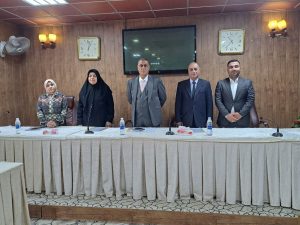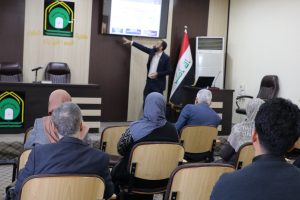Under the auspices of the President of Kerbala University, Prof. Dr. Basem Nayel Al-Saedi, and supervision of the Dean of the Faculty of Science, Dr. Jassim Hanoun Hashim, the master dissertation of the student Hamad Hameed Kadhum, in the Chemistry department, has been conducted in the faculty of science, entitled “Preparation, Characterization of Spinel Metal Chromite/Metal Oxide Nanocomposite and Application on the Colored Material”. This took place in the Great Hall of the College of Science on Wednesday 13/10/2021 AD.
The researcher has stated that the practical part was divided into three main parts: The first part explains the preparation of the Luminol reagent, the ligand (Luminol-Tyrosine) and the Fe(II)-(Luminol-Tyrosine) reagent, and the preparation was confirmed by Uv-Visible, FTIR, and HNMR spectra, microanalysis of the elements (CHN), melting point and Jeddah hybridization of the complex FeL2CL2 in the form of octahedral. This was proven using the method of molar ratios and measurement of magnetic sensitivity, where it turned out to be 1:2 0. The second part focused on the preparation of COCr2O4 spinel using the co-precipitation method. The surface of COCr2O4 spinel has been modified by selecting ZrO2 to improve its properties. And composites of spinel fused COCr2O4 with ZrO2 in different proportions (1:2 and 1:3) were prepared using ultrasound technology as a simple and environmentally friendly method. 2 and 1:3) are nanoscale sizes ranging from 8.1785 nm to 15.5823 nm.
ZrO2 < superimposed 1: 3 < superimposed 1: 2 < COCr2O4, spinel
The second part of the SEM spectra gave an idea of the surface shape of the studied photocatalysts. The spinel shape of CoCr2O4 and the rest of the photocatalysts are almost spherical except for ZrO2 that is spherical in shape. The measured particle sizes were determined by SEM spectra and found that from 17.89 nm to 52.62 nm and all studied samples are considered as nanocrystals. Through the EDX spectrum, all the elements that make up the photocatalysts are presented and there are no impurities with them. The spectra detect the presence of CO, Cr, Zr, and O in the composite cobalt chromite and its composite nanomaterials. The Tauc equation was used to find all kinds of band gaps for the studied photocatalysts. The bandgaps are indirect for all samples and their value increases with increasing ZrO2. The sequence of band gap values is Bg spinel CoCr2O4 < Bg Comp.1: 2 < Bg Comp.1: 3 < Bg ZrO2, equal to 3.2 eV < 4.7 eV < 4.8eV < 5 eV. In the third part, the studied optical stimuli were applied. The photochromic decolorization of the FeL2CL2 compound at pH 7.3 was estimated using commercial CoCr2O4 and ZrO2 spinel and compounds 1:2 and 1:3. Compound 1:3 is the best compound compared to compound 1:2,. The 1:3 compound did not occur because the compound is very stable,
Among the supervisors of the thesis, Dr. Lama and Dr. Muhannad, the aim of this work is:
1 Preparation of COCr2O4 spinel by co-precipitation method.
2- Preparation of COCr2O4 / ZrO2) by ultrasound.
3- A study of the properties of the synthesized Spinel CoCr2O4 and commercial ZrO2 and the synthesized compound (COCr2O4/ZrO2) by X-ray diffraction (XRD) and electron microscopy (SEM) and energy dispersive X-ray (EDX) and band gap (Bg)).
4- Verify the photocatalytic activity of the prepared COCr2O4 spinel, commercial ZrO2 and (COCr2O4 / ZrO2) by studying the effect of the following parameters on the decolorization of the solution such as:
The researcher obtained an honorarium and mentions that the study was conducted under the supervision of Prof. Dr. Luma Majeed Ahmed from the Faculty of Science, University of Kerbala, and Prof. Dr. Muhannad Musa Karim and the Faculty of Science at Babylon University. The discussion committee was composed of Prof. Dr. Eman Talib Kareem (chairman) from the Faculty of Science, University of Kerbala, and Professor Assistant Dr. Rajaa Khader Muhammad, a member of the College of Science, University of Kerbala, and Assistant Professor Dr. Fatima Al-Zahra Jabbar Jassim, a member of the College of Pharmacy, Babylon University.






























































